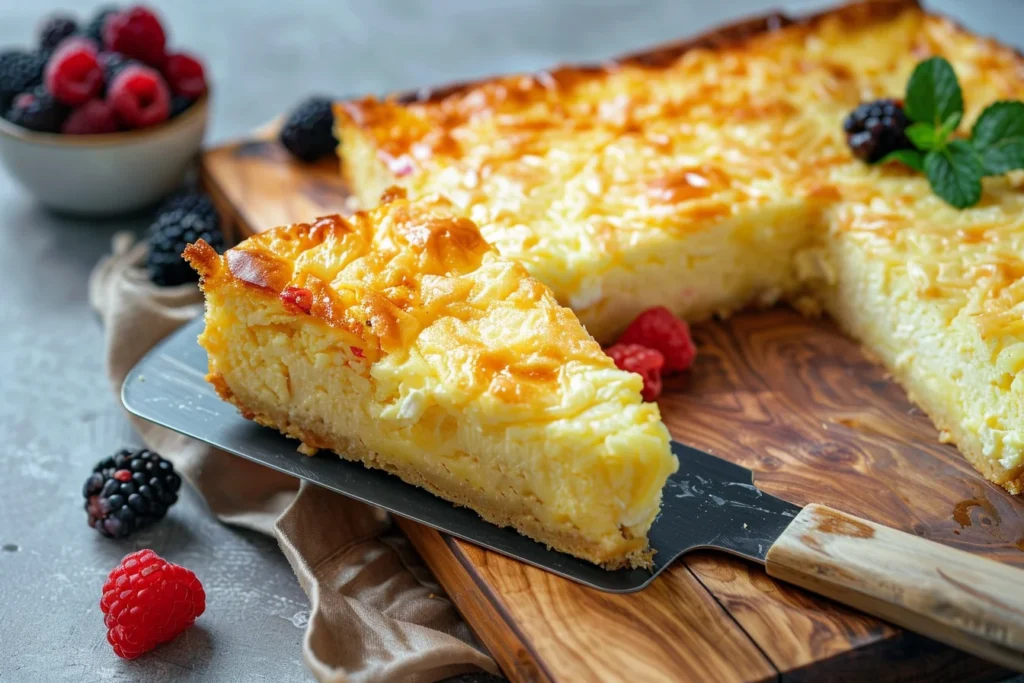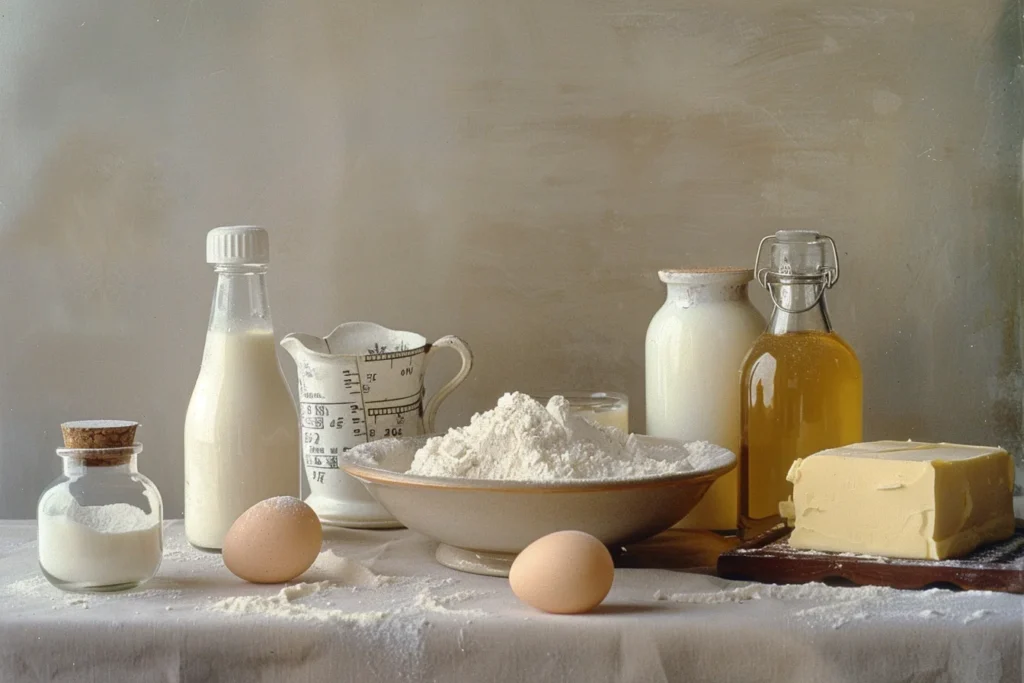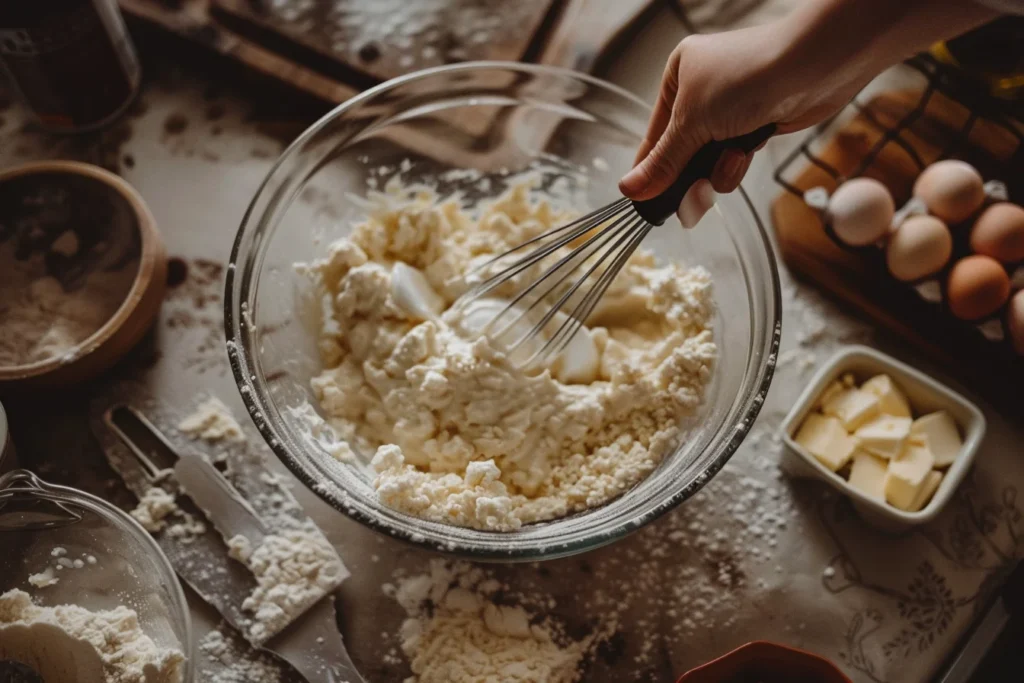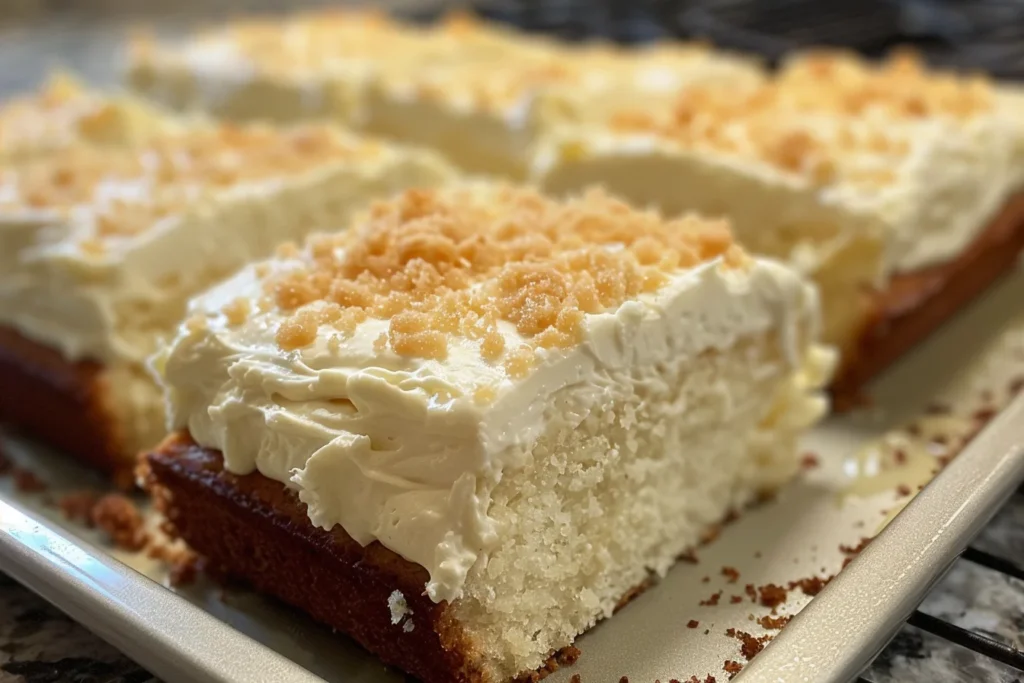
Have you ever baked a cake that turned out too dense, too dry, or didn’t rise properly? 🤔 Most of the time, the culprit is inaccurate measurements. When it comes to making a kefir sheet cake, getting the measurements right is crucial for achieving that perfect moist, fluffy texture. If you’ve been struggling with inconsistent results, don’t worry—I’ve got you covered.
In this guide, we’ll dive deep into the exact measurements needed for a kefir sheet cake, explore common problems and solutions, and even discuss how to adjust the recipe for different pan sizes. Let’s make sure your next cake is nothing short of perfection! 🎂
What Is a Kefir Sheet Cake and Why Are Measurements Important?
Let’s start with the basics. What exactly is a kefir sheet cake? It’s a soft, tender cake made using kefir, a fermented dairy product known for its tangy flavor and health benefits. Think of kefir as yogurt’s thinner, more probiotic-rich cousin.
The magic of kefir lies in its acidic nature, which reacts with baking soda to create air bubbles, making the cake rise beautifully. But here’s the catch—if your measurements are off, this reaction won’t happen properly, and your cake will suffer.
The Role of Kefir in Baking: Texture, Moisture, and Flavor
Kefir isn’t just a trendy ingredient—it’s a game-changer in baking. Here’s why:
- Texture: Kefir tenderizes the gluten in flour, resulting in a softer crumb.
- Moisture: Its liquid content adds moisture to the batter, preventing a dry cake.
- Flavor: Kefir adds a subtle tang that balances the sweetness of the cake.
“Think of kefir as a secret weapon—it not only makes your cake rise but also adds a depth of flavor that’s hard to achieve with regular milk.”
How Incorrect Measurements Can Ruin Your Kefir Sheet Cake
Ever wondered why some cakes turn out heavy and dense while others are light and airy? It all comes down to measurements. Here’s what happens when you don’t measure accurately:
- Too much flour = A dense, heavy cake
- Too little kefir = A dry cake with no rise
- Too much baking soda = An unpleasant metallic taste
- Too little sugar = A bland, lifeless cake
The good news? These mistakes are easily avoidable if you follow precise measurements. Let’s move on to the exact ratios you need for a perfect kefir sheet cake.
Table of Contents
Essential Ingredients and Their Ideal Measurements for Kefir Sheet Cake

When baking a kefir sheet cake, every ingredient plays a crucial role. Below is a breakdown of the essential ingredients and their ideal measurements to achieve the best results.
Kefir: How Much to Use for the Perfect Cake
The star ingredient of this cake is, of course, kefir. But how much should you use?
✅ Ideal Measurement:
1 cup (240 ml) of plain kefir for a standard 9×13-inch sheet pan.
Using too little kefir can result in a dry cake, while too much can make the batter too thin. If you’re using homemade kefir, make sure it’s not too watery.
Flour Types and Quantities: All-Purpose, Whole Wheat, and More
Flour provides the structure of your cake, but using the wrong amount can drastically change the outcome.
✅ Ideal Measurement:
2 cups (250 grams) of all-purpose flour for a balanced texture.
You can substitute some of the flour with whole wheat flour for a nuttier flavor, but don’t go overboard. Whole wheat flour can make the cake denser if not balanced with enough kefir.
“Think of flour as the bones of your cake—it holds everything together. But add too much, and you’ll end up with a brick instead of a cake.” 🧱
Sugar: Balancing Sweetness Without Overdoing It
Sugar does more than just sweeten the cake—it also helps with browning and moisture retention.
✅ Ideal Measurement:
1 cup (200 grams) of granulated sugar for a perfectly sweet cake.
If you prefer a less sweet cake, you can reduce the sugar to ¾ cup (150 grams). You can also experiment with natural sweeteners like honey or maple syrup, but keep in mind they add moisture, so you may need to adjust the liquid ingredients.
Baking Soda vs. Baking Powder: Correct Ratios for the Best Rise
Here’s where things can get tricky. Baking soda reacts with the acidity in kefir to create carbon dioxide bubbles, making your cake rise.
✅ Ideal Measurement:
1 teaspoon of baking soda is enough to react with 1 cup of kefir.
Too much baking soda can cause a bitter, metallic taste. If you prefer to use baking powder, adjust the ratio to 2 teaspoons of baking powder for every cup of kefir.
Eggs and Fats: Butter, Oil, or a Combination?
Eggs and fats contribute to the cake’s richness and texture. But should you use butter, oil, or a combination?
✅ Ideal Measurement:
- 2 large eggs for structure and stability.
- ½ cup (120 ml) of oil or melted butter for moisture.
Oil makes the cake lighter and keeps it moist for longer, while butter adds a richer flavor. You can use a mix of both for the best of both worlds!
Step-by-Step Guide to Measuring Ingredients for Kefir Sheet Cake
Accurate measurements are the key to a successful cake. Here’s how to get it right every time.

Tools You’ll Need: Measuring Cups, Spoons, and Kitchen Scale
Before you start, make sure you have the right tools:
- Measuring cups for dry ingredients
- Measuring spoons for small quantities
- A kitchen scale for precise measurements (especially for flour)
✅ Pro Tip: Always sift your flour before measuring to avoid dense cakes caused by packed flour.
Tips for Accurate Measurements: Avoiding Common Mistakes
Here are a few tips to avoid measurement mishaps:
- Use the spoon-and-level method for flour. Don’t scoop directly from the bag!
- Crack eggs in a separate bowl to avoid shells in your batter.
- Measure liquids at eye level to ensure accuracy.
“Measuring ingredients is like following a map—get one turn wrong, and you’ll end up lost (or with a flat cake!).” 🗺️
Mixing Techniques and the Impact of Measurement Accuracy
Once you’ve measured your ingredients, it’s time to mix. But be careful!
- Overmixing can activate gluten and make the cake tough.
- Undermixing can leave you with lumps of flour.
✅ Pro Tip: Mix until the ingredients are just combined. The batter should be smooth but not overworked.
Common Problems and Solutions Related to Kefir Sheet Cake Measurements
Even when you think you’ve followed the recipe perfectly, things can go wrong. Cakes can end up too dense, too dry, or not rising properly. Let’s look at some of the most common problems and how to fix them.
Why Did My Cake Turn Out Dense? (Too Much Flour) 😟
A dense cake is usually the result of too much flour or overmixing the batter. When you add more flour than needed, it absorbs too much liquid, making the cake heavy and dry.
💡 Solution:
- Use the spoon-and-level method to measure flour.
- Don’t scoop flour directly from the bag—it can pack more flour than needed.
- Mix gently to avoid overworking the batter.
Why Did My Cake Not Rise Properly? (Incorrect Baking Soda Ratio) 🧪
If your cake is flat or didn’t rise as expected, it’s likely because of incorrect baking soda measurements. Baking soda reacts with kefir’s acidity to create bubbles that help the cake rise.
💡 Solution:
- Ensure you’re using 1 teaspoon of baking soda per cup of kefir.
- Check the freshness of your baking soda. Expired baking soda won’t react properly.
“Think of baking soda as the cake’s air pump—without it, your cake won’t rise to its full potential!” 🎈
Why Is My Cake Too Dry? (Too Little Kefir or Fat) 🧁
A dry cake often means you didn’t use enough liquid ingredients or fat in your batter. Kefir is a key ingredient for keeping the cake moist.
💡 Solution:
- Use at least 1 cup of kefir for a standard 9×13-inch sheet cake.
- Add ½ cup of oil or melted butter to retain moisture.
- Avoid overbaking the cake, as this can dry it out.
How to Fix a Batter That’s Too Thick or Too Thin ⚖️
If your batter seems off, you can adjust it before baking.
💡 For a Thick Batter:
- Add a splash of kefir or milk to loosen it up.
💡 For a Thin Batter:
- Add a tablespoon of flour at a time to thicken it up.
Adjusting Kefir Sheet Cake Measurements for Different Pan Sizes
Sometimes, you may want to bake your kefir sheet cake in a smaller or larger pan. But how do you adjust the recipe without ruining the cake? Let’s break it down.
Standard Sheet Pan Size and Ideal Batter Volume 📏
The standard size for a sheet cake is 9×13 inches. For this size, the measurements we discussed earlier (1 cup of kefir, 2 cups of flour, etc.) are perfect.
If you’re using a different pan size, you’ll need to adjust the batter volume and baking time.
| Pan Size | Batter Volume | Baking Time |
|---|---|---|
| 8×8 inch | Half the recipe | 30-35 minutes |
| 9×13 inch (standard) | Full recipe | 35-40 minutes |
| 11×15 inch | 1.5x the recipe | 30-35 minutes |
💡 Pro Tip:
Always fill your pan halfway to two-thirds full to avoid overflow and ensure the cake rises evenly.
Scaling the Recipe for Smaller or Larger Cakes
If you want to scale the recipe, here’s a quick guide:
- For a Half Recipe: Cut all ingredients in half. Use a smaller pan (like 8×8 inches).
- For a Double Recipe: Double all ingredients. Use a larger pan (like 11×15 inches).
How to Adjust Baking Time Based on Pan Size
The thickness of the batter in the pan affects how long it needs to bake.
- Thinner cakes (in larger pans) bake faster.
- Thicker cakes (in smaller pans) take longer.
💡 General Rule:
- Check the cake at 30 minutes and continue baking if needed.
- Use a toothpick test—if it comes out clean, the cake is done!
Customizing Your Kefir Sheet Cake with Add-Ins: Measurements for Extras
Want to get creative? You can customize your kefir sheet cake with fruits, nuts, spices, and more. But it’s important to get the measurements right to avoid ruining the cake’s texture.
Fruits: How Much to Add Without Ruining the Texture
Fruits add flavor and moisture to your cake, but too much can make it soggy.
✅ Ideal Measurement:
- ½ to 1 cup of chopped fruits (like berries, apples, or bananas).
💡 Pro Tip:
Coat fruits in a little flour before adding them to the batter to prevent them from sinking to the bottom.
Nuts and Seeds: Getting the Right Crunch Without Overpowering the Cake
Nuts and seeds add a nice crunch, but too many can make the cake too dense.
✅ Ideal Measurement:
- ¼ to ½ cup of chopped nuts or seeds.
Try adding walnuts, almonds, or chia seeds for a unique twist.
Spices and Flavorings: Vanilla, Cinnamon, Lemon Zest, and More 🌿
Spices and flavorings can completely transform your cake’s taste.
✅ Ideal Measurement:
- 1 teaspoon of vanilla extract
- ½ teaspoon of cinnamon
- Zest of 1 lemon or orange
💡 Pro Tip:
Don’t be afraid to experiment with flavors! Vanilla and lemon zest make a classic combo, while cinnamon and nutmeg add a cozy, spiced twist.
“Customizing your kefir sheet cake is like accessorizing an outfit—just a little extra flair can make a huge difference.” 🎩
Storing and Reheating Your Kefir Sheet Cake
Once your kefir sheet cake is baked to perfection, you’ll want to keep it fresh and moist for as long as possible. Proper storage and reheating methods are key to maintaining that fluffy texture and delicious flavor.
How to Store Your Cake to Retain Moisture
If you’ve ever had cake that’s gone dry after a day, you know how disappointing it can be. Here’s how to store your kefir sheet cake to retain moisture and extend shelf life:
- Room Temperature:
If you plan to eat the cake within 1-2 days, store it at room temperature in an airtight container or cover it tightly with plastic wrap. - Refrigerator:
For longer storage (up to a week), place the cake in the fridge. Make sure it’s wrapped well to avoid absorbing other fridge odors. - Freezer:
Want to keep it longer? Freeze the cake for up to 3 months. Wrap it tightly in plastic wrap and then in foil to prevent freezer burn.
💡 Pro Tip:For best results, freeze individual slices to make reheating easier.
Reheating Tips to Avoid Drying Out the Cake 🔥
Reheating cake can be tricky. If you’re not careful, you’ll end up with a dry, crumbly mess. Here’s how to do it right:
- Microwave:
Place a slice of cake on a microwave-safe plate. Cover it with a damp paper towel and heat for 10-15 seconds. The moisture from the paper towel will help keep the cake soft. - Oven:
Preheat your oven to 300°F (150°C). Wrap the cake in foil to retain moisture and bake for 10-15 minutes. - Room Temperature:
If you don’t want to use heat, let the cake sit at room temperature for about 30 minutes to soften naturally.
Health Benefits of Using Kefir in Baking
You’re not just making a delicious cake—you’re also getting a health boost from the kefir! Let’s look at some of the key health benefits of using kefir in your baking.
Probiotic Power for Gut Health
Kefir is packed with probiotics, which are good bacteria that support gut health. These probiotics can help with digestion, reduce inflammation, and even boost your immune system.
“Think of kefir as your cake’s secret ingredient for health—a delicious way to get your daily dose of probiotics!”
Reduced Fat and Sugar Needs
Because kefir adds natural moisture and tangy flavor, you can reduce the amount of fat and sugar in your cake recipe without sacrificing taste.
- Use less oil or butter.
- Cut back on sugar—the tangy kefir balances the sweetness.
Nutrient-Rich Ingredients
Kefir is a rich source of calcium, protein, and vitamins like B12 and D. These nutrients are essential for strong bones, muscle function, and energy production.
Frequently Asked Questions (FAQs) About Kefir Sheet Cake Measurements
Let’s answer some of the most common questions people ask about kefir sheet cake measurements to help you troubleshoot and perfect your recipe.
What Is the Best Ratio of Kefir to Flour for a Sheet Cake?
The ideal ratio is 1 cup of kefir to 2 cups of flour. This balance ensures the cake stays moist and fluffy while still holding its structure.
Can0 I Use Greek Yogurt Instead of Kefir? How Will It Affect Measurements?
Yes, you can use Greek yogurt as a substitute for kefir. However, Greek yogurt is thicker than kefir, so you’ll need to thin it out with a little milk or water.
💡 Adjustment: For every 1 cup of kefir, use ¾ cup of Greek yogurt plus ¼ cup of milk.
How Much Baking Soda Should I Use for a Kefir Cake?
Use 1 teaspoon of baking soda for every 1 cup of kefir. The acidity in kefir reacts with baking soda to create bubbles that help the cake rise.
How Do I Adjust Measurements for a Gluten-Free Version?
If you’re making a gluten-free kefir sheet cake, use a 1:1 gluten-free flour blend in place of regular flour. Keep all other measurements the same.
💡 Pro Tip:
Add 1 extra egg to help with structure, as gluten-free cakes can be more fragile.
Can I Cut the Recipe in Half? What Adjustments Are Needed?
Absolutely! To make a smaller cake:
- Use ½ cup of kefir.
- Use 1 cup of flour.
- Adjust baking time to about 25-30 minutes.

Conclusion: Mastering Kefir Sheet Cake Measurements for Perfect Results 🎉
CoCongratulations! You’ve now learned everything there is to know about kefir sheet cake measurements. From the ideal ingredient ratios to common problems and solutions, you’re ready to bake a cake that’s moist, fluffy, and full of flavor.
To enhance your baking experience, explore our guide on How to Measure Ingredients for the Best Kefir Sheet Cake, which offers detailed tips on achieving precision in your recipes. You can also learn about the key components in Kefir Sheet Cake Ingredients to ensure you’re using the best possible base for your cake.
If you’re interested in elevating your cake’s flavor profile, check out Flavoring Milk Kefir to discover exciting ways to infuse unique tastes into your sheet cake.
Remember, accurate measurements are the key to success. Whether you’re baking a classic kefir sheet cake or experimenting with new flavors, follow the tips in this guide to achieve perfect results every time.
“Baking is a science, but it doesn’t have to be intimidating. With the right measurements, you can create magic in your kitchen.” ✨
🎂 Happy Baking! 🎂
